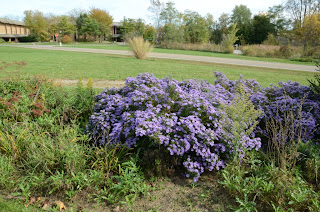From my office window, I can see these sprawling bush-like shale-barren asters, Symphyotrichum oblongifolium. These specimens are so luxuriant that I thought they might be something else, but apparently some nurseryman has worked cultivar magic and amped them up somehow. A few colleagues planted them last year in what we term our "butterfly garden".
So copious are the blossoms that, up close, it's like looking at a big violet-blue cloud. Unlike many cultivars, these asters apparently produce tons of nectar, as the plants were swarming with pollinators. I spent perhaps ten minutes stalking around the asters with my lens, and saw an incredible number of honey bees, in addition to the following buterflies: cabbage white, checkered skipper, common buckeye, monarch, pearl crescent, and Peck's skipper. Also a praying mantis, numerous syrphid flower flies, and a Virginia ctenucha moth.
Several monarchs dropped in and were working the flowers. Sustenance for their long flight to the high-elevation fir forests of Mexico.
I was pleased to see this checkered skipper busily nectaring. It's the first of this species I've seen on the property.
Feisty as always, three or four common buckeyes duked it out wth each other between turns at the flower bar.
Of course, wherever such abundance of tasty pollinators occur, there'll be predators such as this jumbo female Chinese mantis.
What's not to like? Asters are one of Nature's greatest expressions of fall. They enliven landscapes well after most other plants have gone to wither, and the little starlike flowers are nonpareil. There are several dozen native species and all look good, although shale-barren aster is hard to top in the looks department. Obviously they aren't just eye candy - animals galore flock to the flowers, and by having some asters in the corral, you'll be truly green.
NOTE: Thanks to Brian Parsons of the Holden Arboretum for setting me straight on aster ID. I never bothered to look at the details of these plants, being overly smitten with their pollinators, and foolishly assumed them to be New England asters, possibly the robust "purple dome" cultivar. Brian suggested checking the plants carefully, and a quick examination confirmed his suspicions. Thank you Brian!







1 comment:
Glad to help and would bet that your plants are either teh cultivar called 'Raydon's Favorite' or 'October Skies' - Brian
Post a Comment